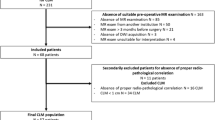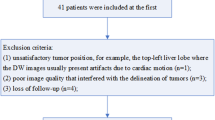Abstract
Objectives
Before diffusion-weighted imaging (DWI) can be implemented in standard clinical practice for response monitoring, data on reproducibility are needed to assess which differences outside the range of normal variation can be detected in an individual patient. In this study we assessed the reproducibility of the apparent diffusion coefficient (ADC) values in colorectal liver metastases. To provide a biological basis for these values, their relation with histopathology was assessed.
Methods
DWI was performed twice in 1 week in patients scheduled for metastasectomy of colorectal liver metastases. Correlation between ADC values and apoptosis marker p53, anti-apoptotic protein BCL-2, proliferation marker Ki67 and serum vascular endothelial growth factor (VEGF) concentration were assessed.
Results
A good reproducibility coefficient of the mean ADC (coefficient of reproducibility 0.20 × 10−3 mm2/s) was observed in colorectal liver metastases (n = 21). The ADC value was related to the proliferation index and BCL-2 expression of the metastases. Furthermore, in metastases recently treated with systemic therapy, the ADC was significantly higher (1.27 × 10−3 mm2/s vs 1.05 × 10−3 mm2/s, P = 0.02).
Conclusions
The good reproducibility, correlation with histopathology and implied sensitivity for systemic treatment-induced anti-tumour effects suggest that DWI might be an excellent tool to monitor response in metastatic colorectal cancer.
Key Points
• ADC values are becoming important oncological biomarkers
• DWI provides reproducibile ADC values in colorectal liver metastases
• The coefficient of reproducibility of the mean ADC is 0.20 × 10 −3 mm 2 /s
• ADC values correlate with proliferation index and are related to BCL-2 expression







Similar content being viewed by others
References
Malvezzi M, Bertuccio P, Levi F, La Vecchia C, Negri E (2012) European cancer mortality predictions for the year 2012. Ann Oncol 23:1044–1052
Manfredi S, Lepage C, Hatem C, Coatmeur O, Faivre J, Bouvier AM (2006) Epidemiology and management of liver metastases from colorectal cancer. Ann Surg 244:254–259
Tol J, Koopman M, Cats A et al (2009) Chemotherapy, bevacizumab, and cetuximab in metastatic colorectal cancer. N Engl J Med 360:563–572
Heijmen L, Verstappen MC, Ter Voert EE et al (2012) Tumour response prediction by diffusion-weighted MR imaging: ready for clinical use? Crit Rev Oncol Hematol 83:194-207
Koh DM, Collins DJ (2007) Diffusion-weighted MRI in the body: applications and challenges in oncology. AJR Am J Roentgenol 188:1622–1635
Yablonskiy DA, Sukstanskii AL (2010) Theoretical models of the diffusion weighted MR signal. NMR Biomed 23:661–681
Zhang XY, Sun YS, Tang L, Xue WC, Zhang XP (2011) Correlation of diffusion-weighted imaging data with apoptotic and proliferation indexes in CT26 colorectal tumor homografts in balb/c mouse. J Magn Reson Imaging 33:1171–1176
Cui Y, Zhang XP, Sun YS, Tang L, Shen L (2008) Apparent diffusion coefficient: potential imaging biomarker for prediction and early detection of response to chemotherapy in hepatic metastases. Radiology 248:894–900
Dzik-Jurasz A, Domenig C, George M et al (2002) Diffusion MRI for prediction of response of rectal cancer to chemoradiation. Lancet 360:307–308
Mardor Y, Roth Y, Ochershvilli A et al (2004) Pretreatment prediction of brain tumors’ response to radiation therapy using high b-value diffusion-weighted MRI. Neoplasia 6:136–142
Herneth AM, Guccione S, Bednarski M (2003) Apparent diffusion coefficient: a quantitative parameter for in vivo tumor characterization. Eur J Radiol 45:208–213
Uhl M, Saueressig U, van Buiren M et al (2006) Osteosarcoma: preliminary results of in vivo assessment of tumor necrosis after chemotherapy with diffusion- and perfusion-weighted magnetic resonance imaging. Invest Radiol 41:618–623
De Vita F, Orditura M, Lieto E et al (2004) Elevated perioperative serum vascular endothelial growth factor levels in patients with colon carcinoma. Cancer 100:270–278
Galizia G, Lieto E, Ferraraccio F et al (2004) Determination of molecular marker expression can predict clinical outcome in colon carcinomas. Clin Cancer Res 10:3490–3499
Hamstra DA, Galban CJ, Meyer CR et al (2008) Functional diffusion map as an early imaging biomarker for high-grade glioma: correlation with conventional radiologic response and overall survival. J Clin Oncol 26:3387–3394
Kim SH, Lee JY, Lee JM, Han JK, Choi BI (2011) Apparent diffusion coefficient for evaluating tumour response to neoadjuvant chemoradiation therapy for locally advanced rectal cancer. Eur Radiol 21:2567–2574
Koh DM, Scurr E, Collins D et al (2007) Predicting response of colorectal hepatic metastasis: value of pretreatment apparent diffusion coefficients. AJR Am J Roentgenol 188:1001–1008
Mardor Y, Pfeffer R, Spiegelmann R et al (2003) Early detection of response to radiation therapy in patients with brain malignancies using conventional and high b-value diffusion-weighted magnetic resonance imaging. J Clin Oncol 21:1094–1100
Song I, Kim CK, Park BK, Park W (2010) Assessment of response to radiotherapy for prostate cancer: value of diffusion-weighted MRI at 3T. AJR Am J Roentgenol 194:W477–W482
Desar IM, van Laarhoven HW, Hambrok T et al (2010) Assessment of early vascular effects of the angiogenesis inhibitor sunitinib (SU) in renal cell carcinoma (RCC) by dynamic contrast enhanced MRI (DCE-MRI) and diffusion weight MRI (DWI) at 3 tesla (T). ASCO Annual Meeting, June 4-8, 2010, Chicago, IL (abstract)
Kim SY, Lee SS, Byun JH et al (2010) Malignant hepatic tumors: short-term reproducibility of apparent diffusion coefficients with breath-hold and respiratory-triggered diffusion-weighted MR imaging. Radiology 255:815–823
Rademakers SE, Rijken PF, Peeters WJ et al (2011) Parametric mapping of immunohistochemically stained tissue sections; a method to quantify the colocalization of tumor markers. Cell Oncol (Dordr) 34:119–129
Bland JM, Altman DG (1986) Statistical methods for assessing agreement between two methods of clinical measurement. Lancet 1:307–310
van Laarhoven HW, Rijpkema M, Punt CJ et al (2003) Method for quantitation of dynamic MRI contrast agent uptake in colorectal liver metastases. J Magn Reson Imaging 18:315–320
Hatt M, Cheze-Le Rest C, Aboagye EO et al (2010) Reproducibility of 18F-FDG and 3′-deoxy-3′-18F-fluorothymidine PET tumor volume measurements. J Nucl Med 51:1368–1376
Munro AJ, Lain S, Lane DP (2005) P53 abnormalities and outcomes in colorectal cancer: a systematic review. Br J Cancer 92:434–444
Stefanini MO, Wu FT, Mac Gabhann F, Popel AS (2010) Increase of plasma VEGF after intravenous administration of bevacizumab is predicted by a pharmacokinetic model. Cancer Res 70:9886–9894
Hsei V, Deguzman GG, Nixon A, Gaudreault J (2002) Complexation of VEGF with bevacizumab decreases VEGF clearance in rats. Pharm Res 19:1753–1756
Nagy JA, Benjamin L, Zeng H, Dvorak AM, Dvorak HF (2008) Vascular permeability, vascular hyperpermeability and angiogenesis. Angiogenesis 11:109–119
Acknowledgments
Supported by a grant from the Dutch Cancer Society (KWF Kankerbestrijding), no. KUN 2008-4098.
Author information
Authors and Affiliations
Corresponding author
Rights and permissions
About this article
Cite this article
Heijmen, L., ter Voert, E.E.G.W., Nagtegaal, I.D. et al. Diffusion-weighted MR imaging in liver metastases of colorectal cancer: reproducibility and biological validation. Eur Radiol 23, 748–756 (2013). https://doi.org/10.1007/s00330-012-2654-4
Received:
Revised:
Accepted:
Published:
Issue Date:
DOI: https://doi.org/10.1007/s00330-012-2654-4




